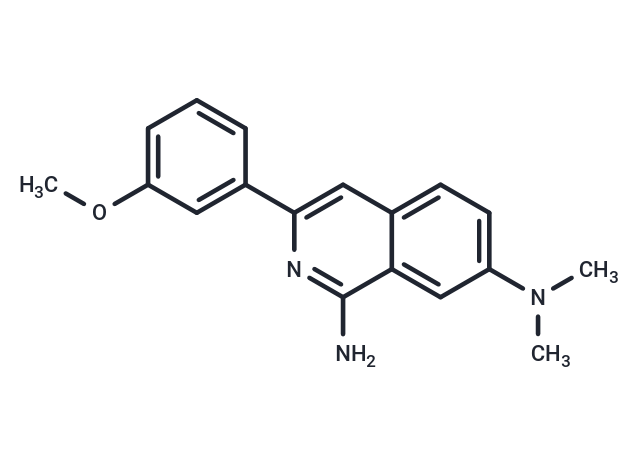购物车
- 全部删除
 您的购物车当前为空
您的购物车当前为空

3-arylisoquinolinamine derivative is a compound with antitumor activity.


为众多的药物研发团队赋能,
让新药发现更简单!
3-arylisoquinolinamine derivative is a compound with antitumor activity.
| 规格 | 价格 | 库存 | 数量 |
|---|---|---|---|
| 2 mg | ¥ 495 | 5日内发货 | |
| 5 mg | ¥ 828 | 5日内发货 | |
| 10 mg | ¥ 1,620 | 5日内发货 | |
| 100 mg | ¥ 7,320 | 6-8周 | |
| 1 mL x 10 mM (in DMSO) | ¥ 913 | 5日内发货 |
| 产品描述 | 3-arylisoquinolinamine derivative is a compound with antitumor activity. |
| 靶点活性 | OVCAR-3 (ovary):14 nM , Pancreas PANC-1:19 nM , Kidney Caki-1:22 nM , Prostate PC3:19 nM , SNB19 (Glioblastoma):32 nM , MDA-MB-231 cells:21 nM , Colon HCT 116 cells:17 nM , SK-MEL-28 cells:32 nM |
| 体外活性 | 3-arylisoquinolinamine derivative (7b) shows more effective activity against Paclitaxel-resistant HCT-15 human colorectal cancer cell lines when compared to the original cytotoxic cancer drug, Paclitaxel. The cell cycle dynamics is analyzed by flow cytometry. Treatment of human HCT-15 cells with 3-arylisoquinolinamine derivative (7b) blocks or delays the progression of cells from the G0/G1 phase into the S phase, and induces cell death. 3-arylisoquinolinamine derivative (7b) inhibits the cell growth (IC50: 14 nM to 32 nM). In cell cycle analysis using HCT-15 cells, the treatment of 1 nM of 3-arylisoquinolinamine derivative (7b) displays a significant increase in G0/G1 phase at 24 h with a decrease in G2/M phase, but the increase of G0/G1 phase at 48 h is not significant. At a higher concentration of 3-arylisoquinolinamine derivative (7b) (10 nM), there are a significant increase in G0/G1 phase and a decrease in G2/M phase, and the emergence of sub-G1phase, at both 24 h and 48 h. 3-arylisoquinolinamine derivative (7b) blocks or delays the progression of cells from the G0/G1 phase into S phase, and induces cell death [1]. 3-arylisoquinolinamine derivative (compound 13; IC50: 15 nM in HCT-15 cells, 17 nM in HCT116 cells) shows potent antiproliferative activities with IC50 value in the low nanomolar range in both cells and higher antitumor activities than that of Paclitaxel against Paclitaxel-resistant HCT-15 colorectal cancer cells [2]. |
| 体内活性 | 3-arylisoquinolinamine derivative has higher antitumor efficacy (69.2 % inhibition) than that of the control drug, Paclitaxel (48.8 % inhibition) in the inhibition of growth of tumor in an animal model [2]. |
| 动物实验 | The six-week-old female athymic mice (BALB/c nu/nu) are used. All study medications (vehicle control, Paclitaxel: 10 mg/kg/day, 3-arylisoquinolinamine derivative: 10 mg/kg/day) are given by intraperitoneal injections three times per week starting from day 10 and ending on day 29 after inoculation of HCT 15 cells. To quantify tumor growth, three perpendicular diameters of the tumors are measured with calipers every 3-5 days, and the bodyweight of the mice was monitored for toxicity. The tumor volume is calculated [2]. |
| 分子量 | 293.36 |
| 分子式 | C18H19N3O |
| CAS No. | 1029008-71-6 |
| 密度 | 1.190 g/cm3 (Predicted) |
| 存储 | Powder: -20°C for 3 years | In solvent: -80°C for 1 year | Shipping with blue ice. | |||||||||||||||||||||||||||||||||||
| 溶解度信息 | DMSO: 50 mg/mL (170.44 mM), Sonication is recommended. | |||||||||||||||||||||||||||||||||||
溶液配制表 | ||||||||||||||||||||||||||||||||||||
DMSO
| ||||||||||||||||||||||||||||||||||||
评论内容